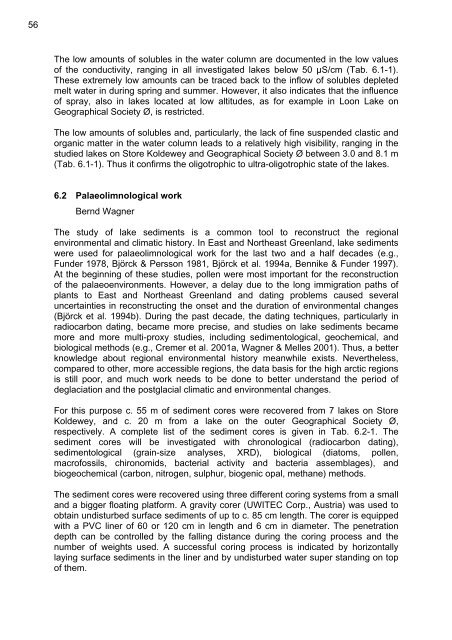the Expedition ARKTIS-XIX/4 of the research vessel POLARSTERN ...
the Expedition ARKTIS-XIX/4 of the research vessel POLARSTERN ...
the Expedition ARKTIS-XIX/4 of the research vessel POLARSTERN ...
Create successful ePaper yourself
Turn your PDF publications into a flip-book with our unique Google optimized e-Paper software.
56<br />
The low amounts <strong>of</strong> solubles in <strong>the</strong> water column are documented in <strong>the</strong> low values<br />
<strong>of</strong> <strong>the</strong> conductivity, ranging in all investigated lakes below 50 µS/cm (Tab. 6.1-1).<br />
These extremely low amounts can be traced back to <strong>the</strong> inflow <strong>of</strong> solubles depleted<br />
melt water in during spring and summer. However, it also indicates that <strong>the</strong> influence<br />
<strong>of</strong> spray, also in lakes located at low altitudes, as for example in Loon Lake on<br />
Geographical Society Ø, is restricted.<br />
The low amounts <strong>of</strong> solubles and, particularly, <strong>the</strong> lack <strong>of</strong> fine suspended clastic and<br />
organic matter in <strong>the</strong> water column leads to a relatively high visibility, ranging in <strong>the</strong><br />
studied lakes on Store Koldewey and Geographical Society Ø between 3.0 and 8.1 m<br />
(Tab. 6.1-1). Thus it confirms <strong>the</strong> oligotrophic to ultra-oligotrophic state <strong>of</strong> <strong>the</strong> lakes.<br />
6.2 Palaeolimnological work<br />
Bernd Wagner<br />
The study <strong>of</strong> lake sediments is a common tool to reconstruct <strong>the</strong> regional<br />
environmental and climatic history. In East and Nor<strong>the</strong>ast Greenland, lake sediments<br />
were used for palaeolimnological work for <strong>the</strong> last two and a half decades (e.g.,<br />
Funder 1978, Björck & Persson 1981, Björck et al. 1994a, Bennike & Funder 1997).<br />
At <strong>the</strong> beginning <strong>of</strong> <strong>the</strong>se studies, pollen were most important for <strong>the</strong> reconstruction<br />
<strong>of</strong> <strong>the</strong> palaeoenvironments. However, a delay due to <strong>the</strong> long immigration paths <strong>of</strong><br />
plants to East and Nor<strong>the</strong>ast Greenland and dating problems caused several<br />
uncertainties in reconstructing <strong>the</strong> onset and <strong>the</strong> duration <strong>of</strong> environmental changes<br />
(Björck et al. 1994b). During <strong>the</strong> past decade, <strong>the</strong> dating techniques, particularly in<br />
radiocarbon dating, became more precise, and studies on lake sediments became<br />
more and more multi-proxy studies, including sedimentological, geochemical, and<br />
biological methods (e.g., Cremer et al. 2001a, Wagner & Melles 2001). Thus, a better<br />
knowledge about regional environmental history meanwhile exists. Never<strong>the</strong>less,<br />
compared to o<strong>the</strong>r, more accessible regions, <strong>the</strong> data basis for <strong>the</strong> high arctic regions<br />
is still poor, and much work needs to be done to better understand <strong>the</strong> period <strong>of</strong><br />
deglaciation and <strong>the</strong> postglacial climatic and environmental changes.<br />
For this purpose c. 55 m <strong>of</strong> sediment cores were recovered from 7 lakes on Store<br />
Koldewey, and c. 20 m from a lake on <strong>the</strong> outer Geographical Society Ø,<br />
respectively. A complete list <strong>of</strong> <strong>the</strong> sediment cores is given in Tab. 6.2-1. The<br />
sediment cores will be investigated with chronological (radiocarbon dating),<br />
sedimentological (grain-size analyses, XRD), biological (diatoms, pollen,<br />
macr<strong>of</strong>ossils, chironomids, bacterial activity and bacteria assemblages), and<br />
biogeochemical (carbon, nitrogen, sulphur, biogenic opal, methane) methods.<br />
The sediment cores were recovered using three different coring systems from a small<br />
and a bigger floating platform. A gravity corer (UWITEC Corp., Austria) was used to<br />
obtain undisturbed surface sediments <strong>of</strong> up to c. 85 cm length. The corer is equipped<br />
with a PVC liner <strong>of</strong> 60 or 120 cm in length and 6 cm in diameter. The penetration<br />
depth can be controlled by <strong>the</strong> falling distance during <strong>the</strong> coring process and <strong>the</strong><br />
number <strong>of</strong> weights used. A successful coring process is indicated by horizontally<br />
laying surface sediments in <strong>the</strong> liner and by undisturbed water super standing on top<br />
<strong>of</strong> <strong>the</strong>m.

















